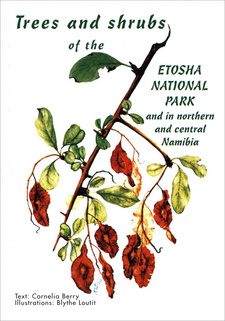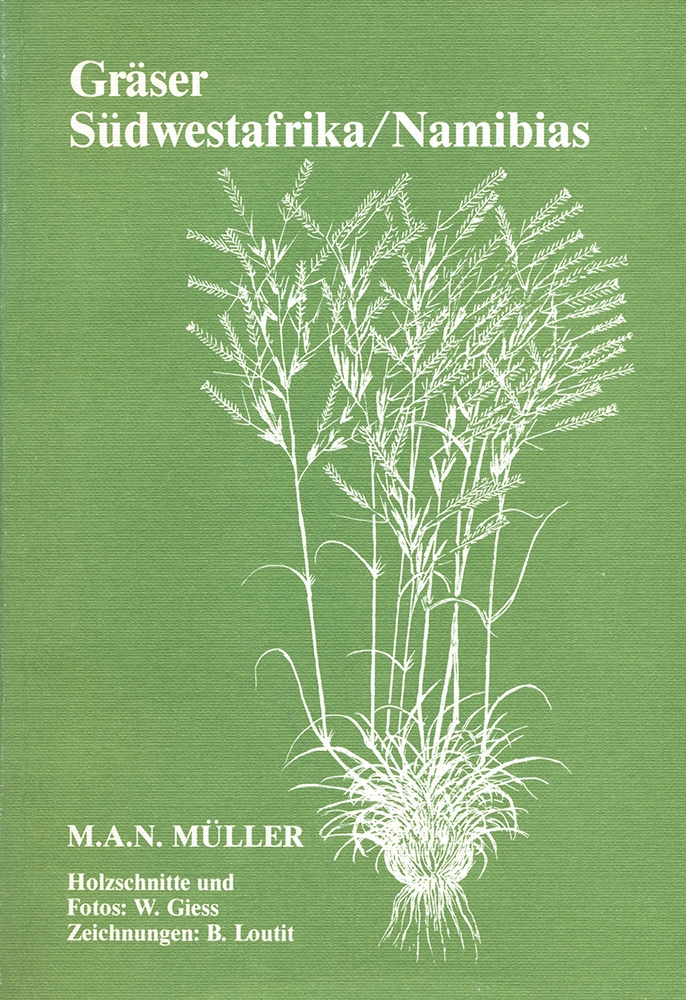Trees and Shrubs of the Etosha National Park and in Northern and Central Namibia, by Conny Berry and Blythe Loutit.

Trees and Shrubs of the Etosha National Park and in Northern and Central Namibia, by Conny Berry and Blythe Loutit. Namibia Scientific Society. 3rd edition, Windhoek, Namibia 2002. ISBN 9991640177 / ISBN 99916-40-17-7 / ISBN 9789991640174
The revision of this book, Trees and Shrubs of the Etosha National Park and in Northern and Central Namibia, by Conny Berry and Blythe Loutit, 15 years after its appearance, took place when major changes in both plant nomenclature and co-workers' situation had occurred.
Descriptions Of The Major Vegetation Types
1. Saline desert
The main saline pan is a depression of about 5 000 km2, measuring a maximum of 120 km east-west and 55 km north-south. Its geological formation evolved during the Pliocene epoch (between two and 10 million years ago) when the Kunene River flowed into the Ekuma Lake, of which the Etosha Pan was an extension. Later the Kunene River changed course towards the Ruacana Falls in the west, thus cutting off the water supply of the lake. During the drying-up period the soil of the pan became very brackish. Wind erosion deepened the depression and in places impermeable clay up to 240 m deep formed on the floor. During the rainy season, which is from December to April, the pan may be partially flooded, most of the water coming from two rivers in the north, the Ekuma and the Oshigambo. Another, the Omuramba Owambo, enters the Etosha Pan in the east through Fischer's Pan, a finger-like extension of the main pan at Namutoni. Analysis of the water in the pan shows it to be unfit for human or animal consumption, as it may contain twice as much salt as sea-water. Nevertheless, it supports a rich growth of blue-green algae which in good rainy seasons attracts a million or more flamingoes which may breed there. When the water dries up, little vegetation grows on the pan, with the exception of a specific, salt-loving (halophytic) grass, Sporobolus salsus. This protein-rich grass yields good grazing for thousands of blue wildebeest, springbok and zebra during the dry winter season. Areas adjacent to the pan have a very brackish soil and support only halophytic vegetation such as the grasses Sporobolus spicatus and Odyssea paucinervis and a small shrub Suaeda articulata.
2. Dwarf shrub savanna
The fringes surrounding the pan support a variety of small shrubs such as Salsola etoshensis, Petalidium engleranum, Monechma genistifolium, Monechma tonsum, Leucosphaera bainesii and Cyathula lanceolata which cover large areas of alkaline soils. Acacia nebrownii and Aloe littoralis occur close to the edge of the pan, as in the vicinity of Salvadora.
3. Grasslands
These are mainly at the perimeter of the pan on sandy soils overlying limestone. Annual and perennial grasses are interspersed with clumps of Acacia nebrownii, Acacia luederitzii var. luederitzii, Acacia reficiens subsp. reficiens and Catophractes alexandri. The treeless Andoni plain, which covers 4 400 ha to the north-east of the pan, is a typical grassland, dominated by the tall perennial grass, Sporobolus spicatus. Along the western and north-western shore of the pan are the Okondeka grasslands. Here sandy soils support mainly perennials such as Eragrostis sabinae and Odyssea paucinervis. Grootvlakte (great plain) is located between Sprokieswoud (haunted forest) and the Charl Marais Dam, along a western extension of the main pan. Covering an area of 400 km2, it supports annuals such as Enneapogon desvauxii, Eragrostis annulata, E. glandulosipedata and the perennial E.nindensis. This is the main summer grazing area for the plains animals such as Burchell's zebra, blue wildebeest and springbok, attracted by the "sweet" and highly nutritious grasses during the rainy season. The winter grazing areas, which sustain less palatable grasses, are the Halali plains, extending from Charitsaub to Nuamses and Gemsbokvlakte, covering an area of almost 30 000 ha. The dominant grass there is the perennial Monelytrum luederitzianum. [...]
This is an excerpt from Trees and Shrubs of the Etosha National Park and in Northern and Central Namibia, by Conny Berry and Blythe Loutit.
Title: Trees and Shrubs of the Etosha National Park and in northern and central Namibia
Authors: Conny Berry; Blythe Loutit
Publisher: Namibia Scientific Society
3rd edition, Windhoek, Namibia 2002
ISBN 9991640177 / ISBN 99916-40-17-7
ISBN 9789991640174
Softcover, 15 x 21 cm, 164 pages, 54 bw-sketches, 14 colour plates, 1 map
Berry, Cornelia und Loutit, Blythe im Namibiana-Buchangebot
Trees and Shrubs of the Etosha National Park and in Northern and Central Namibia
Guide to 50 of the most common trees and shrubs of Etosha National Park and in northern and central Namibia.
Gräser Südwestafrikas/Namibias
Die seltene deutsche Ausgabe von Gräser Südwestafrikas/Namibias stellt 115 Pionier-, Subklimax- oder Klimaxgräser auf dem Stand von 1985 vor.
Tree Atlas of Namibia
The Tree Atlas of Namibia presents the distribution and estimated abundance of over 400 species of woody plants in Namibia.
Der wundersame Elefant der Namib
Der wundersame Elefant der Namib ist eine reizende Kindergeschichte über die bekannten Dünenelefanten in Namibia.
The magic elephant of the Namib
The magic elephant of the Namib is a nearly true story and set in a remote area of Namibia.
Touring Sesriem and Sossusvlei
A guide to plants and animals of the Namib area of Sesriem and Sossusvlei, its history, geology, ecology and touring routes.
Bäume und Sträucher des Etoscha-Nationalparks
Die örtlich vorkommenden Bäume und Sträucher des Etoscha-Nationalparks in Namibia sind in diesem wunderbar-zeitlosen Naturführer einzigartig dargestellt und beschrieben.
Bäume und Sträucher im Etoscha Nationalpark und in Nord- und Zentral-Namibia
Fünfzig der häufigsten Bäume und Sträucher Nord- und Zentral-Namibias mit dem Etoscha-Nationalpark sind in diesem botanischen Führer beschrieben und illustriert.








